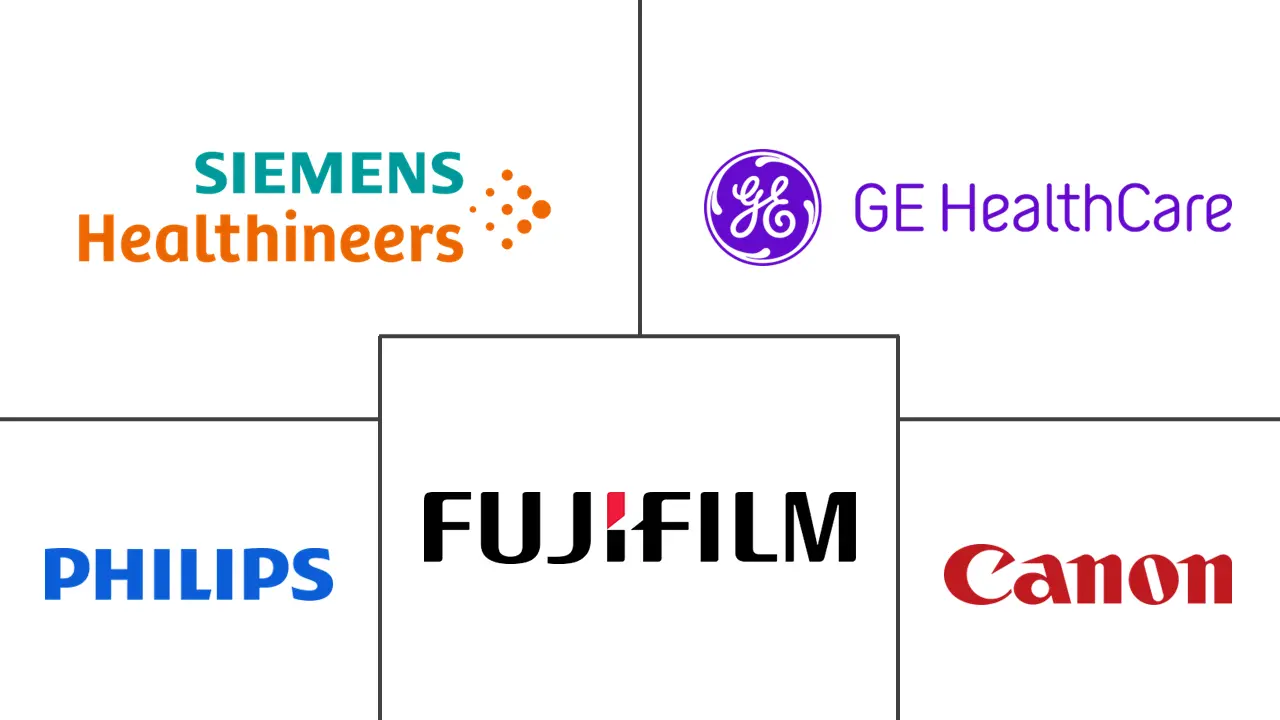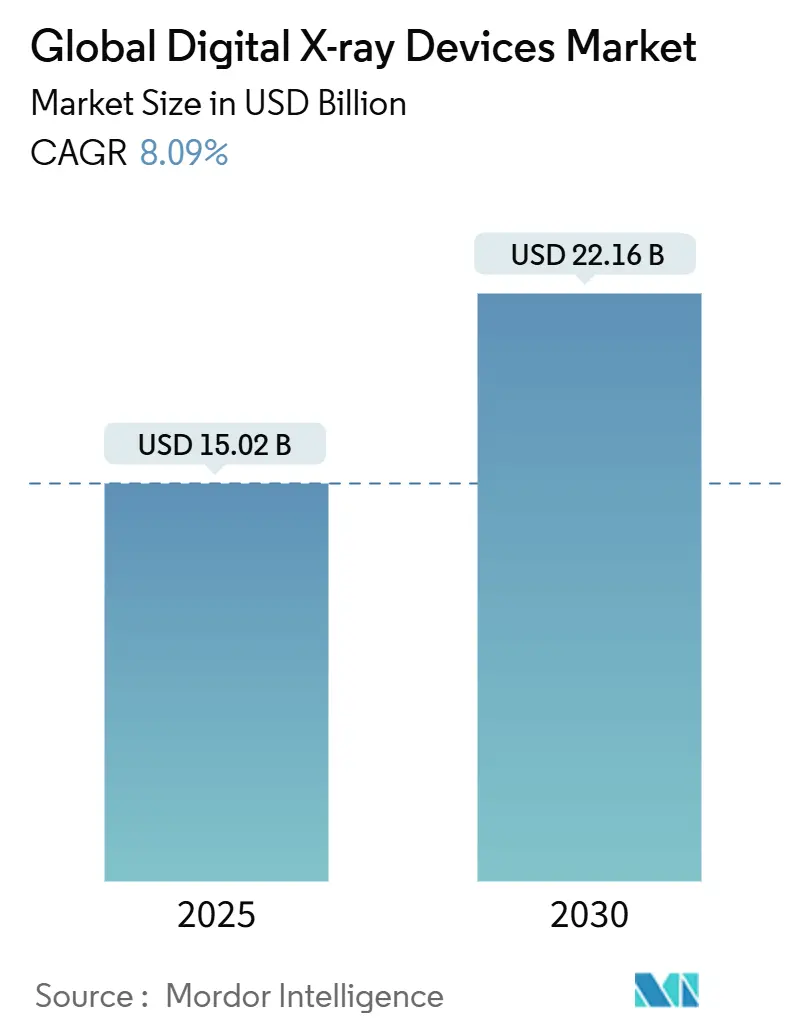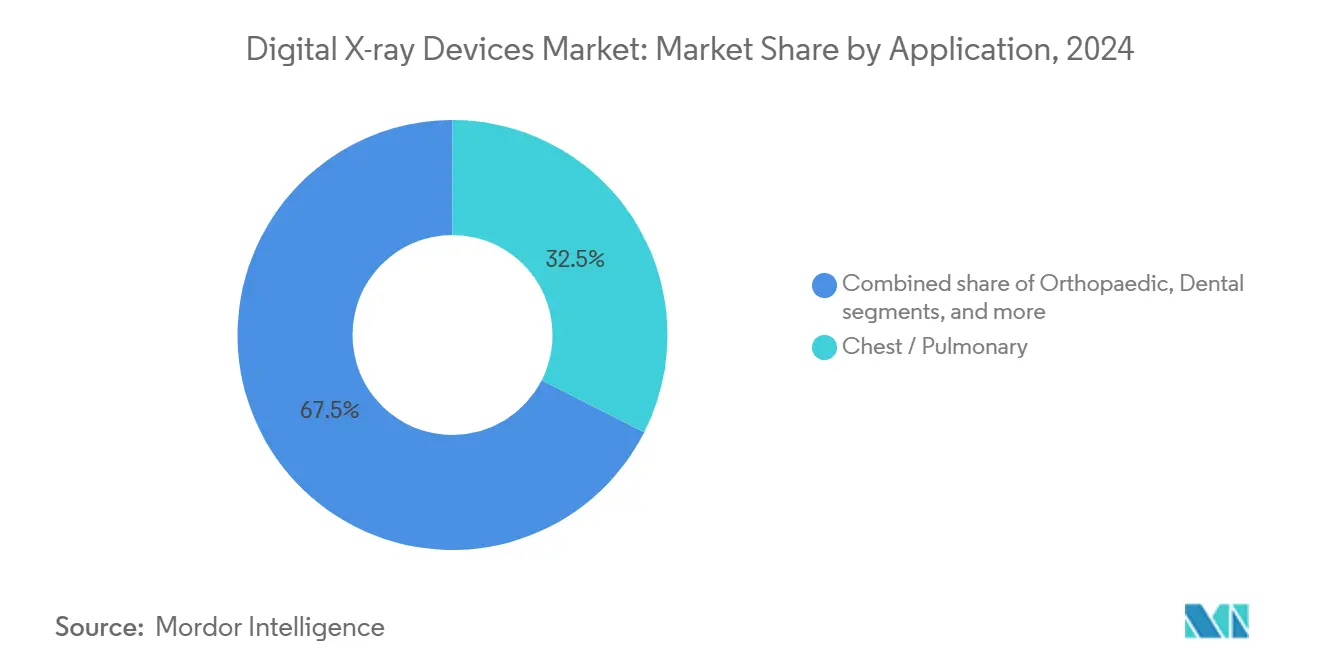Global Digital X-ray Devices Market Analysis by Mordor Intelligence
The digital X-ray devices market size is currently valued at USD 15.02 billion in 2025 and is forecast to reach USD 22.16 billion by 2030, reflecting an 8.09% CAGR over the period. Consistent replacement of film and computed radiography (CR) systems, stronger emphasis on dose management, and expanding AI integration sustain this growth trajectory. Intensified Medicare penalties on CR, rising chronic disease imaging demand, and hospital workflow optimization continue to accelerate direct radiography (DR) upgrades, while portable platforms extend access beyond the hospital campus. AI-ready detectors, photon-counting technology, and cloud-enabled workflow solutions push performance benchmarks higher, creating fresh competitive pressure for traditional vendors. Simultaneously, raw-material constraints in rare-earth scintillators and radiographer staffing gaps introduce operational risk, compelling providers to seek productivity-driven innovations.
Key Report Takeaways
- By technology, direct radiography led with 83.91% of the digital X-ray devices market size in 2024; computed radiography is projected to decline as DR advances at 8.27% CAGR through 2030.
- By application, chest and pulmonary imaging commanded 32.47% revenue share in 2024; dental imaging is poised to expand at an 8.91% CAGR to 2030.
- By portability, fixed room-based systems held 63.86% of the digital X-ray devices market size in 2024, while portable systems exhibit the highest projected CAGR at 8.45% between 2025 and 2030.
- By end-user, hospitals accounted for 57.23% of the digital X-ray devices market share in 2024; ambulatory surgical centers record the fastest growth at 8.83% CAGR through 2030.
- By geography, North America maintained a 38.52% share in 2024; Asia-Pacific is forecast to achieve the quickest regional CAGR at 8.86% through 2030.
Global Digital X-ray Devices Market Trends and Insights
Drivers Impact Analysis
| Driver | (~) % Impact on CAGR Forecast | Geographic Relevance | Impact Timeline |
|---|---|---|---|
| Rising prevalence of chronic & orthopedic disorders | +2.1% | Global, with highest impact in North America & Europe | Long term (≥ 4 years) |
| Rapid detector & AI upgrades in DR panels | +1.8% | North America & APAC core, spill-over to Europe | Medium term (2-4 years) |
| Cost-savings & dose-reduction versus film/CR | +1.5% | Global, particularly emerging markets | Short term (≤ 2 years) |
| Procurement incentives for retrofit upgrades in mid-tier hospitals | +1.2% | North America & Europe, expanding to APAC | Medium term (2-4 years) |
| Growth of point-of-care & home imaging ecosystems | +0.9% | Global, with early adoption in developed markets | Long term (≥ 4 years) |
| Expansion of AI-driven teleradiology networks | +0.7% | Global, accelerated in underserved regions | Medium term (2-4 years) |
Source: Mordor Intelligence
Rising Prevalence of Chronic & Orthopedic Disorders
Global population aging enlarges the base of patients requiring musculoskeletal and chest imaging. Osteoporosis, osteoarthritis, and cardiopulmonary diseases now dominate outpatient diagnostics, driving regular radiographic follow-ups that create repeat equipment utilization. The World Health Organization projects that chronic disorders will account for nearly three-quarters of worldwide deaths by 2030[1]World Health Organization, “Universal Health Coverage (UHC) Fact Sheet,” World Health Organization, who.int, firmly anchoring radiography as a frontline diagnostic tool. AI-enhanced DR platforms add value by detecting subtle vertebral fractures during routine studies, as demonstrated by Nanox AI’s HealthOST algorithm, which uncovered thousands of undiagnosed cases across NHS sites. Early detection lowers downstream costs and supports reimbursement for preventative imaging. Growing orthopedic imaging demand, therefore, sustains consistent unit placements across hospitals, imaging centers, and ambulatory clinics within the digital X-ray devices market.
Rapid Detector & AI Upgrades in DR Panels
Flat-panel detectors now incorporate on-board computing that improves exposure parameters, noise suppression, and automated collimation. Photon-counting architectures further enhance spatial resolution and contrast-to-noise ratios, giving clinicians more diagnostic information at lower doses. Siemens Healthineers, GE Healthcare, and other OEMs invest heavily in joint hardware-software roadmaps that extend competitive life cycles for installed fleets. GE Healthcare’s collaboration with NVIDIA[2]GE Healthcare, “GE Healthcare and NVIDIA Reimagine Diagnostic Imaging,” gehealthcare.com illustrates this pivot, aiming to automate image positioning and quality checks, thereby shortening exam times and improving technologist productivity. Facilities, therefore, prioritize detectors that can receive continuous firmware upgrades, protecting capital investments and reinforcing the digital X-ray devices market’s innovation cadence.
Cost-Savings & Dose-Reduction Versus Film/CR
Direct radiography eliminates film processing, chemical disposal, and physical storage costs. In addition, Medicare imposes a 7% annual reimbursement cut on CR images, accelerating conversion economics for sites still using cassette systems. DR platforms consistently show 30–50% lower radiation exposure while reducing examination cycle times from minutes to seconds, enabling radiology departments to manage higher patient volumes without staff increases. These gains shrink payback periods to under two years for many high-volume centers, making DR adoption financially compelling in both developed and price-sensitive markets. Environmental benefits from eliminating chemicals also resonate with hospital sustainability goals.
Procurement Incentives for Retrofit Upgrades in Mid-Tier Hospitals
Retrofit kits convert existing analog or CR rooms into full DR suites at comparatively modest cost. Wireless detectors and modular workstations minimize room downtime and preserve legacy infrastructure. Government-led managed-equipment service contracts in several emerging economies fund these upgrades, spreading the financial burden over multi-year service payments while guaranteeing uptime. For providers lacking full capital budgets, subscription models and outcome-based payments make DR accessible, which in turn expands addressable volumes within the digital X-ray devices market.
Restraints Impact Analysis
| Restraint | (~) % Impact on CAGR Forecast | Geographic Relevance | Impact Timeline |
|---|---|---|---|
| High CAPEX & total-cost-of-ownership | -1.4% | Global; acute in emerging markets | Short term (≤ 2 years) |
| Reimbursement gaps in outpatient settings | -0.8% | North America & Europe | Medium term (2-4 years) |
| Skilled radiographer shortage for advanced DR & AI workflows | -0.6% | Global; most severe in developed markets | Long term (≥ 4 years) |
| Supply-chain risk in rare-earth scintillators | -0.4% | Global; concentrated in Asia-Pacific | Medium term (2-4 years) |
Source: Mordor Intelligence
High CAPEX & Total-Cost-of-Ownership
Premium DR rooms with advanced AI features can exceed USD 500,000, representing significant financial barriers for small hospitals. Ongoing maintenance contracts, cybersecurity upgrades, and periodic detector replacements inflate lifecycle spending. In the United States, 2025 Physician Fee Schedule adjustments cut global imaging reimbursement by 3.55%, lengthening return-on-investment horizons for new equipment. Facilities therefore scrutinize capital plans more closely, delaying some purchases and selectively favoring retrofit kits or refurbished detectors.
Reimbursement Gaps in Outpatient Settings
Ambulatory and independent imaging centers rely on predictable reimbursements to service equipment leases. Commercial payers increasingly mirror Medicare’s downward adjustments, while new value-based arrangements tie payment to diagnostic outcomes. Smaller centers lack leverage to negotiate higher rates, pressuring margins and limiting DR capital spending. Regulatory complexity surrounding AI reimbursement adds uncertainty, further dampening purchasing appetite among outpatient providers within the digital X-ray devices market.
Segment Analysis
By Application: Chest Imaging Dominance Drives Volume Growth
Chest and pulmonary studies represented 32.47% of the digital X-ray devices market size in 2024. High examination frequency in emergency, critical-care, and routine outpatient settings sustains system utilization and encourages continuous detector upgrades. AI screening algorithms for pneumonia and tuberculosis enhance diagnostic confidence, reinforcing DR as the modality of choice for first-line respiratory evaluation. Dental imaging registers the fastest expansion at an 8.91% CAGR, helped by compact intraoral sensors and AI-assisted caries detection that streamline chairside workflows. Orthopedic imaging also climbs steadily as elderly populations require frequent fracture assessment and postoperative monitoring.
Beyond volumes, chest radiography leads AI adoption because image libraries are large and labeling is standardized, enabling rapid algorithm development. Portable chest systems deployed during infectious disease outbreaks demonstrated clear value, ensuring continuity of care while reducing cross-contamination risks. Dental practices benefit from three-dimensional reconstruction and cloud-based consults, increasing the revenue potential per visit. Together, these factors broaden the digital X-ray devices market’s application mix, balancing mature high-volume segments with faster-growing specialty niches.
Note: Segment shares of all individual segments available upon report purchase
By Technology: Direct Radiography Transformation Accelerates
Direct radiography platforms captured 83.91% of digital X-ray devices market share in 2024, with continued expansion underpinned by superior image quality, workflow speed, and favorable reimbursement. Photon-counting detectors under evaluation[3]Arie Wibowo, “Development and Challenges in Perovskite Scintillators for High-Resolution Imaging and Timing Applications,” Communications Materials, nature.com show promise for dual-energy separation and lower dose at equal resolution, marking the next leap in detector innovation. Computed radiography remains only in budget-constrained facilities, yet escalating reimbursement penalties and the falling price of entry-level DR units drive conversion.
The digital X-ray devices industry now differentiates primarily on integrated software performance rather than raw detector pixel size. Smart acquisition protocols, predictive maintenance alerts, and automated quality assurance raise clinical confidence while reducing service costs. Consequently, procurement teams assess total software ecosystem capability before committing to hardware, cementing direct radiography’s role as the technology backbone of the digital X-ray devices market.
By Portability: Mobile Systems Drive Access Expansion
Fixed rooms accounted for 63.86% of the digital X-ray devices market size in 2024, serving trauma centers, operating theaters, and radiology departments that require top image fidelity and high throughput. Portable systems advance at an 8.45% CAGR due to point-of-care, ICU, and home-health adoption. Handheld units weighing under 4 kg allow clinicians to perform exams in ambulances, rural clinics, and residential settings without patient transport. Field trials of Fujifilm’s compact X-air registered zero missed appointments, underscoring mobility’s value in geographically dispersed communities.
Battery improvements, lightweight shielding, and Wi-Fi image transfer shorten setup times and speed clinical decisions. Portable DR also supports crisis response, enabling rapid triage during disasters or pandemics. As payers increasingly reimburse for home diagnostics, mobility becomes a core competitive dimension, anchoring future growth across the digital X-ray devices market.
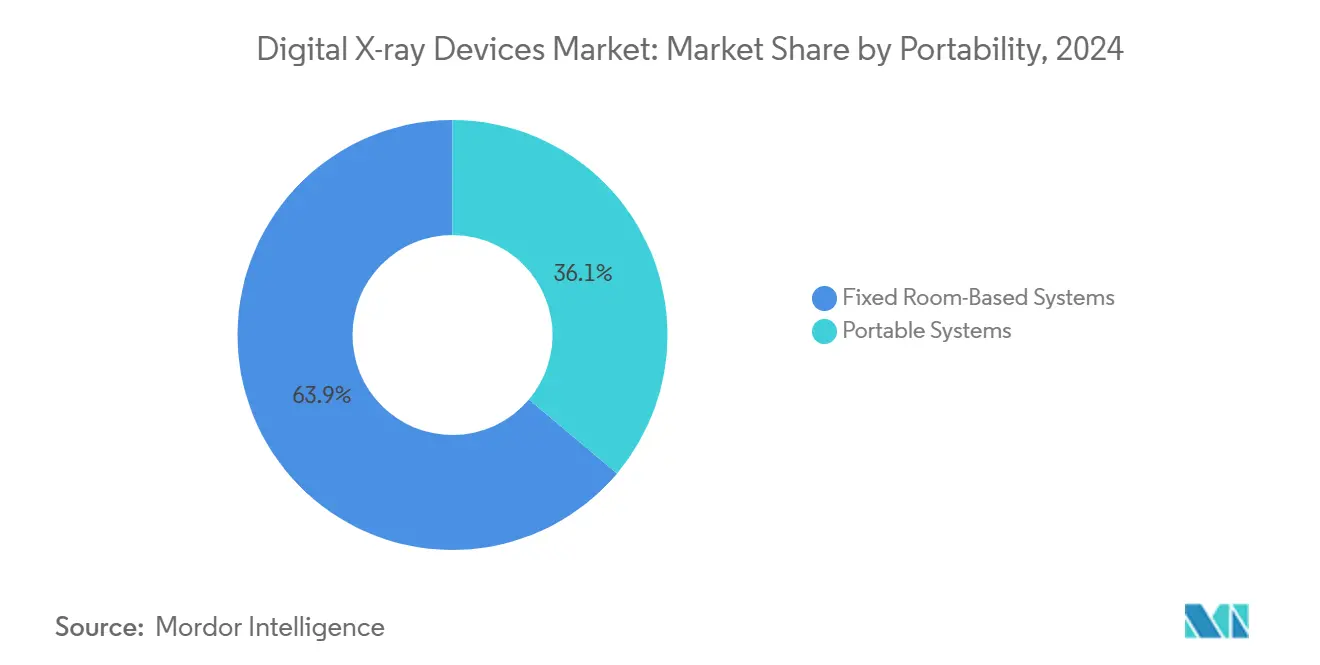
Note: Segment shares of all individual segments available upon report purchase
By End-User: Ambulatory Centers Lead Growth Transformation
Hospitals retained 57.23% of the digital X-ray devices market share in 2024, leveraging broad service lines and night-and-day staffing to generate exam volume. Nonetheless, ambulatory surgical centers record an 8.83% CAGR through 2030, fueled by payer preference for lower-cost outpatient procedures and patient demand for convenient care. Imaging-only centers and urgent-care clinics also purchase compact DR suites to differentiate service offerings.
The digital X-ray devices market size for ambulatory settings rises further as AI tools reduce reliance on specialized technologists, mitigating the 18.1% vacancy rate reported for radiologic technologists in 2024. Equipment vendors respond with turnkey packages that bundle training, cloud PACS, and remote support. These solutions enable smaller sites to deploy sophisticated imaging with limited staffing, driving incremental unit sales and reinforcing decentralization trends.
Geography Analysis
North America generated 38.52% of 2024 revenue within the digital X-ray devices market, anchored by mature hospital networks and accelerated upgrade cycles motivated by Medicare penalties. OEMs raised detector shipments after U.S. hospitals prioritized radiation safety, cybersecurity, and AI readiness in their 2025 capital budgets. Canada applies similar dose-reduction targets, while Mexico’s Seguro Popular replacement scheme channels funding toward provincial imaging centers. Despite this scale, annual growth moderates to 7.43% as substitution rather than new installation dominates demand.
Asia-Pacific is the fastest-growing territory at 8.86% CAGR, propelled by multi-billion-dollar public hospital construction programs and expanding middle-class insurance coverage. China’s Healthy China 2030 blueprint mandates imaging capacity expansion at county level, incentivizing regional OEMs to localize detector assembly. India’s smart-city and Ayushman Bharat initiatives increase rural diagnostic reach, spurring sales of rugged portable DR. Meanwhile, Japanese and South-Korean providers purchase high-end photon-counting prototypes for cardiovascular and oncology subspecialties. Supply-chain risk in rare-earth scintillators, however, could inflate end prices if export restrictions persist, injecting volatility into Asia-Pacific procurement cycles.
Europe posts a steady 7.79% CAGR to 2030 as universal health systems replace aging CR fleets. The European Radiation Protection Directive enforces dose-tracking software, elevating AI-ready DR adoption. Germany and France invest in teleradiology networks to serve rural regions, while the United Kingdom advances community diagnostic hubs that favor portable DR. Middle East & Africa demonstrates 8.35% CAGR owing to multi-clinic investments in Gulf Cooperation Council states and expanding insurance penetration in South Africa. South America grows 8.12% as Brazil’s public-private concession model funds diagnostic equipment, combating historical under-supply.
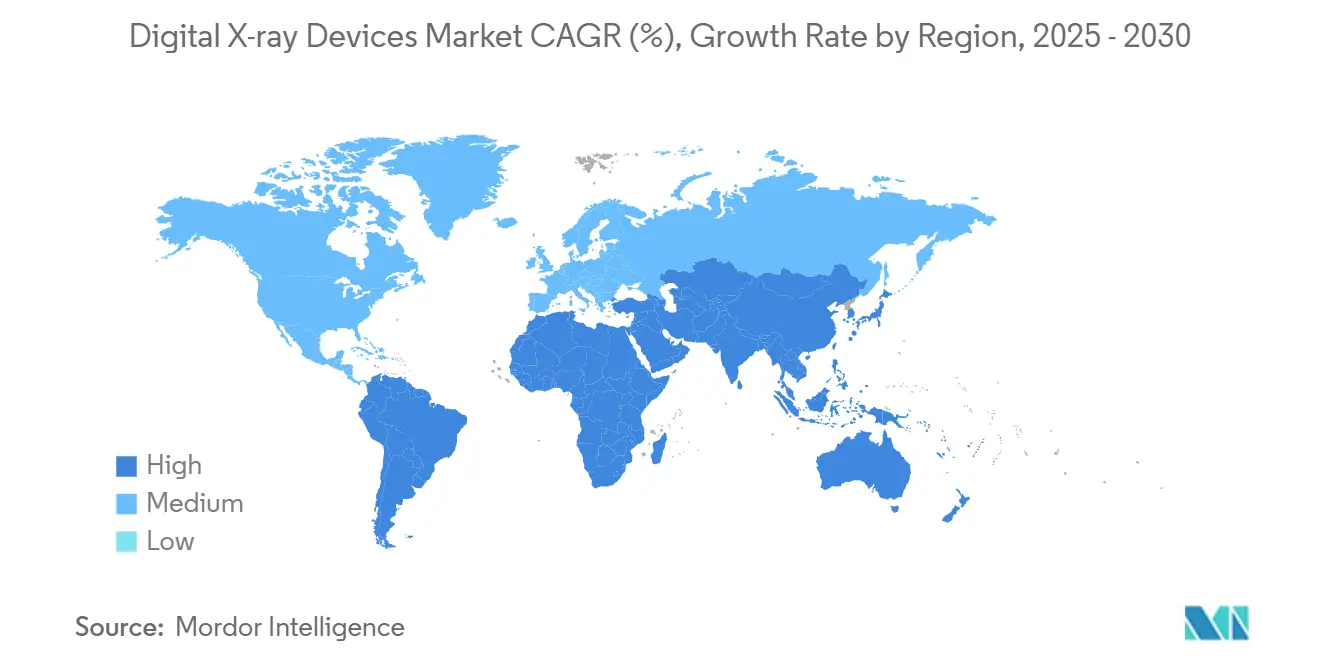
Competitive Landscape
First-tier multinationals—Siemens Healthineers, GE Healthcare, and Philips—maintain extensive portfolios spanning room-based suites, mobile carts, detectors, and enterprise informatics. They benefit from vertically integrated service agreements and established channel networks, capturing multi-year managed-equipment contracts with large health systems. Siemens channeled USD 27.38 billion into med-tech development and opened new high-throughput detector lines in 2025, securing long-term supply continuity. GE Healthcare’s 2025 collaboration with NVIDIA positions the firm at the forefront of autonomous workflow solutions, re-shaping competitive dynamics toward software value.
Second-tier manufacturers such as Canon Medical, Agfa-Gevaert, Carestream, and Fujifilm leverage specialized imaging heritage and cost-efficient production to address value-oriented segments. They differentiate through retrofit kits, wireless detectors, and tailored financing packages that resonate with mid-tier hospitals. Meanwhile, specialized disruptors like Nanox target affordability with cold-cathode X-ray source designs[4]Nano-X Imaging Ltd., “Nanox Receives FDA Clearance for New Imaging System,” investors.nanox.vision, using subscription models to penetrate low-resource markets. AI-only vendors, including Aidoc and Lunit, partner with hardware OEMs to bundle decision-support algorithms, migrating competitive emphasis from physical components to image intelligence.
Patent filings for photon-counting sensors, perovskite scintillators, and automated collimation exceed 5,000 applications since 2022, indicating sustained innovation velocity. Supply-chain alliances with scintillator suppliers and electronics fabs have become critical strategic levers, particularly after China’s export-licensing framework on gadolinium and lutetium. Vendors hedging with multi-regional supply agreements and recycling programs gain resilience, an increasingly important differentiator within the digital X-ray devices market.
Global Digital X-ray Devices Industry Leaders
-
Canon Medical Systems Corporation
-
Fujifilm Holdings Corporation
-
GE Healthcare
-
Koninklijke Philips N.V.
-
Siemens Healthineers AG
- *Disclaimer: Major Players sorted in no particular order
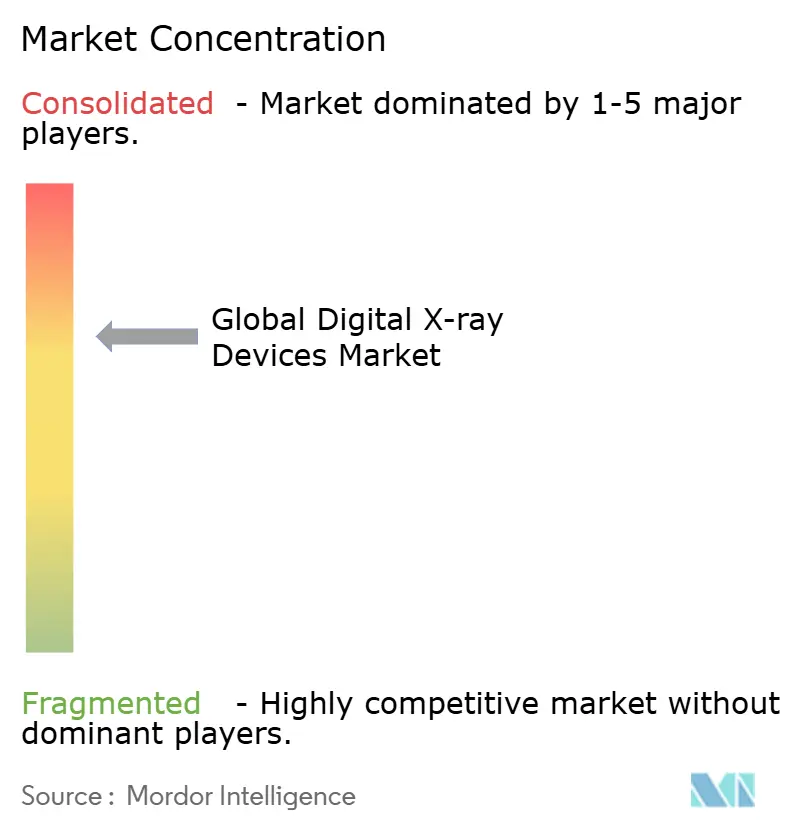
Recent Industry Developments
- April 2025: RadNet acquired iCAD for USD 103 million in stock, expanding AI breast-imaging capabilities and consolidating enterprise workflow assets.
- March 2025: GE Healthcare partnered with NVIDIA to co-develop autonomous X-ray and ultrasound systems that automate patient positioning and optimize exposure.
- December 2024: Nanox received FDA clearance for its ARC tomosynthesis platform covering general and pulmonary imaging indications.
- July 2024: DEXIS introduced the Ti2 intraoral sensor featuring AI-assisted caries detection and seamless practice-software integration.
Global Digital X-ray Devices Market Report Scope
As per the scope of this report, digital X-ray or digital radiography is a form of X-ray imaging where digital X-ray sensors are used instead of traditional photographic films. This has an added advantage of time efficiency and the ability to transfer images digitally, as well as enhance them for better visibility. This method bypasses the chemical processing of photographic films. Digital X-ray imaging has high demand, as it requires less radiation exposure compared to traditional X-rays. The Digital X-ray Devices Market is Segmented by Application (Orthopedic, Cancer, Dental, Cardiovascular, and other applications), Technology (Computed Radiography and Direct Radiography), Portability (Fixed Systems, and Portable Systems), End-User (Hospitals, Diagnostic Centers, Other End Users), and Geography (North America, Europe, Asia-Pacific, Middle East & Africa, and South America). The market report also covers the estimated market sizes and trends for 17 different countries across major regions, globally. The report offers the value (in USD million) for the above segments.
| By Application | Orthopaedic | ||
| Chest / Pulmonary | |||
| Dental | |||
| Cardiovascular | |||
| Oncology | |||
| Other Applications | |||
| By Technology | Computed Radiography (CR) | ||
| Direct Radiography (DR) | Flat-Panel Detectors | ||
| CCD/CMOS Panels | |||
| By Portability | Fixed Room-Based Systems | ||
| Portable Systems | Hand-held Units | ||
| Mobile Carts | |||
| By End-User | Hospitals | ||
| Diagnostic Imaging Centres | |||
| Ambulatory Surgical Centers (ASCs) | |||
| Other End-Users | |||
| By Geography | North America | United States | |
| Canada | |||
| Mexico | |||
| Europe | Germany | ||
| United Kingdom | |||
| France | |||
| Italy | |||
| Spain | |||
| Rest of Europe | |||
| Asia-Pacific | China | ||
| India | |||
| Japan | |||
| Australia | |||
| South Korea | |||
| Rest of Asia-Pacific | |||
| Middle East and Africa | GCC | ||
| South Africa | |||
| Rest of Middle East and Africa | |||
| South America | Brazil | ||
| Argentina | |||
| Rest of South America | |||
| Orthopaedic |
| Chest / Pulmonary |
| Dental |
| Cardiovascular |
| Oncology |
| Other Applications |
| Computed Radiography (CR) | |
| Direct Radiography (DR) | Flat-Panel Detectors |
| CCD/CMOS Panels |
| Fixed Room-Based Systems | |
| Portable Systems | Hand-held Units |
| Mobile Carts |
| Hospitals |
| Diagnostic Imaging Centres |
| Ambulatory Surgical Centers (ASCs) |
| Other End-Users |
| North America | United States |
| Canada | |
| Mexico | |
| Europe | Germany |
| United Kingdom | |
| France | |
| Italy | |
| Spain | |
| Rest of Europe | |
| Asia-Pacific | China |
| India | |
| Japan | |
| Australia | |
| South Korea | |
| Rest of Asia-Pacific | |
| Middle East and Africa | GCC |
| South Africa | |
| Rest of Middle East and Africa | |
| South America | Brazil |
| Argentina | |
| Rest of South America |
Key Questions Answered in the Report
What is driving healthcare providers to replace computed radiography equipment with direct radiography systems?
Reimbursement penalties on legacy technology, combined with workflow efficiencies and radiation-dose reductions delivered by direct radiography, are prompting rapid equipment upgrades.
How are portable digital X-ray units reshaping diagnostic workflows?
Handheld and mobile systems extend imaging to emergency rooms, intensive-care beds, and home-care settings, allowing faster triage and reducing the need to move fragile patients.
Why has artificial intelligence become a key differentiator among digital X-ray vendors?
Embedded algorithms improve image quality, automate positioning, and flag potential abnormalities, enabling facilities to boost throughput and mitigate radiographer shortages.
What supply-chain challenges affect future detector availability?
Export controls on rare-earth elements used in scintillators create sourcing risk, encouraging manufacturers to diversify suppliers and explore alternative materials.
How are ambulatory surgical centers influencing purchasing decisions in the imaging industry?
Their preference for compact, easy-to-install systems that integrate seamlessly with electronic health records is encouraging vendors to develop turnkey, software-centric X-ray solutions.
In what way are retrofit detector kits supporting technology adoption in mid-tier hospitals?
Retrofit options allow facilities to convert existing rooms to digital operation without major construction, spreading capital costs over time while gaining immediate productivity benefits.
Page last updated on: June 20, 2025

